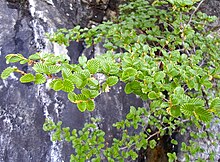Nothofagus gunnii
| Fuscospora gunnii | |
|---|---|
 |
|
| Scientific classification | |
| Kingdom: | Plantae |
| (unranked): | Angiosperms |
| (unranked): | Eudicots |
| (unranked): | Rosids |
| Order: | Fagales |
| Family: | Nothofagaceae |
| Genus: | Fuscospora |
| Species: | F. gunnii |
| Binomial name | |
|
Fuscospora gunnii (Hook.f.) Heenan & Smissen |
|
| Synonyms | |
Nothofagus gunnii (Hook.f.)Oerst.
Fagus gunnii
Fuscospora gunnii, the tanglefoot- or deciduous beech, or fagus, is a deciduous shrub endemic to the highlands of Tasmania, Australia. It was discovered in 1847 by R.C Gunn and evidence exists that it once lived in Antarctica.F. Gunnii was previously included in the genus Nothofagus, although recent DNA analysis has placed it in the genus Fuscospora.F. Gunnii is a small woody tree with a shrubby appearance known to grow up to 3 metres (9.8 ft). It lives only on mountains due to temperature limitations within the Tasmanian maritime climate and can survive up to heights of 1,400 metres (4,600 ft). It grows in alpine and sub-alpine regions in the west to central portions of the state but is absent from the mountains of the northeast. Though capable of reaching the size of a small tree, it rarely exceeds 2 metres (6.6 ft) in height, instead growing as a thick shrub or as a woody ground cover hence its common name of "tanglefoot".
Joseph Dalton Hooker described the tanglefoot beech.
Common names include tanglefoot- or deciduous beech, or fagus, which can also refer to the entire Beech family.
It was known as Nothofagus gunnii until 2013. The change in name is controversial, and it is not necessary to accept this change.
Fuscospora gunnii is a small tree which may grow up to 3 metres tall (growth habit is heavily dependent on the exposure of the site) and has a thick shrubby appearance due to substantial branching. The alternating leaves are simple and ovate with toothed margins and attached by short petioles. Leaf lamina is generally <20mm in length and is distinctly 'crinkled'. It is most easily visually separated from the similar Fagus species Lophozomia cunninghamii (previously Nothofagus cunninghamii), by the crinkled appearance of the leaf lamina. During Autumn and Winter months, the leaves undergo colour change as any other deciduous species does. The leaves of this deciduous species have an average lifespan of around 5 months. The leaves are simple and alternate, growing 1 cm long. The leaf color is bright green, turning yellow, then brilliant red, in autumn. They are almost circular in shape with deep veins which end in the gaps between the rounded teeth on the leaf. The plant has separate male and female flowers on the tree. Both male and female flowers are small and inconspicuous. The fruit is small (about 6 mm wide) and woody, and contains three small winged nuts. In most years seed production is poor, but once in a while a 'mast' crop occurs with high germination. The seeds have a very short viability.
...
Wikipedia
